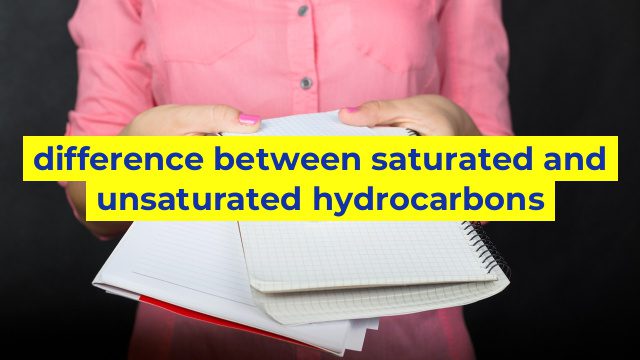The Difference Between Saturated and Unsaturated Hydrocarbons
What are Hydrocarbons?
Hydrocarbons are compounds composed of hydrogen and carbon atoms. They are the building blocks of many organic compounds and are the primary constituents of fossil fuels, such as coal, oil, and natural gas. Hydrocarbons are classified based on their degree of saturation, which determines their physical and chemical properties.
Saturated Hydrocarbons
Saturated hydrocarbons are also known as alkanes or paraffins. They are compounds that consist of carbon and hydrogen atoms connected by single covalent bonds. Saturated hydrocarbons are called “saturated” because they contain the maximum number of hydrogen atoms that can bond to each carbon atom, resulting in a “saturated” bond structure. For example, methane (CH4) is a simple saturated hydrocarbon with one carbon atom and four hydrogen atoms.
Saturated hydrocarbons have a linear or branched chain structure, and they are the most stable of all hydrocarbons due to the presence of single bonds. They are abundant in nature and are found in various forms, such as petroleum, natural gas, and waxes.
Unsaturated Hydrocarbons
Unsaturated hydrocarbons are compounds that contain at least one double or triple bond between two carbon atoms. These bonds are called unsaturated bonds because they have fewer hydrogen atoms than saturated compounds. Unsaturated hydrocarbons are also known as alkenes or alkynes.
Unsaturated hydrocarbons are more reactive than saturated hydrocarbons because of the presence of double or triple bonds, which allow them to undergo addition reactions. Conjugated unsaturated hydrocarbons, such as benzene, play a vital role in organic chemistry and are used in the synthesis of many organic compounds, including plastics, dyes, and pharmaceuticals.
Distinguishing Between Saturated and Unsaturated Hydrocarbons
The difference between saturated and unsaturated hydrocarbons lies in their atomic arrangement. Saturated hydrocarbons have single bonds, while unsaturated hydrocarbons have double or triple bonds. The saturation level of a hydrocarbon is an essential factor that determines its properties, including melting and boiling points, solubility, and reactivity.
In conclusion, the primary difference between saturated and unsaturated hydrocarbons is the type of bond between the carbon atoms. Understanding the difference between these two types of hydrocarbons is crucial for chemists, scientists, and researchers who work with organic molecules.
Table difference between saturated and unsaturated hydrocarbons
| Saturated Hydrocarbons | Unsaturated Hydrocarbons | |
|---|---|---|
| Definition | Hydrocarbons containing only single bonds between carbon atoms | Hydrocarbons containing one or more double or triple bonds between carbon atoms |
| Structure | Linear or branched chains of carbon atoms with hydrogen atoms attached to each carbon | Linear or branched chains of carbon atoms with double or triple bonds between some of the carbon atoms |
| General Formula | CnH2n+2 | CnH2n or CnH2n-2 |
| Physical Properties | Generally less reactive and more stable, have higher boiling points and melting points | More reactive and less stable, have lower boiling points and melting points |
| Chemical Properties | Generally unreactive, don’t undergo addition reactions easily | Highly reactive, undergo addition reactions easily |
| Examples | Methane (CH4), Ethane (C2H6), Propane (C3H8) | Ethene (C2H4), Propene (C3H6), Butene (C4H8) |


